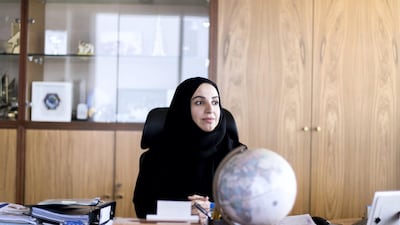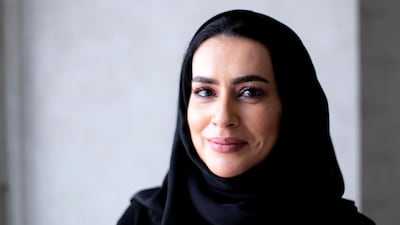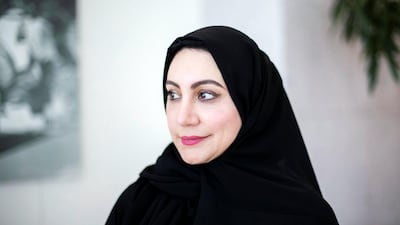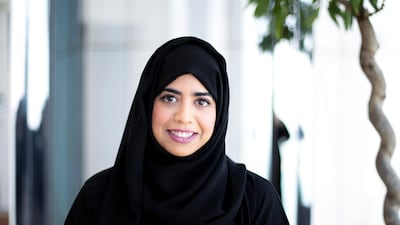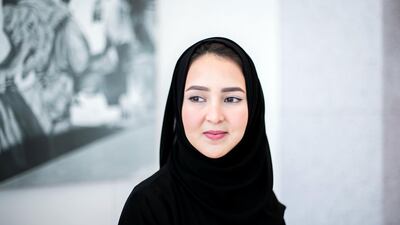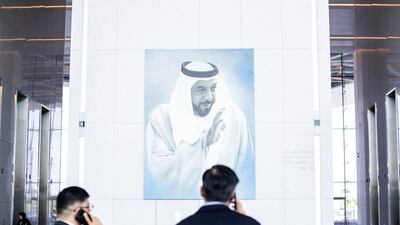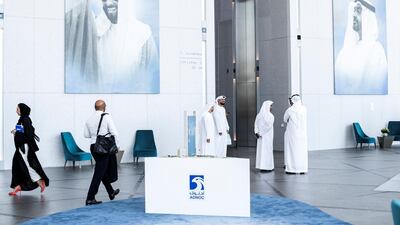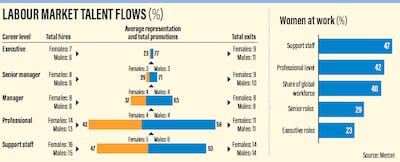When Fatema Al Nuaimi graduated with a degree in chemical engineering and joined Abu Dhabi National Oil Company in the late 1990s, she thought she was set for a career in marketing.
"[They] sold me the idea that being in marketing is a good idea," says Ms Al Nuaimi, who is the first female chief executive at Adnoc LNG.
It was 1999 and Ms Al Nuaimi, who was among the second batch of female chemical engineer graduates from UAE University, previously known as Al Ain University, was keen to prove herself.
To secure her role, she spent a month dropping off her resume to 14 Adnoc subsidiaries along the Abu Dhabi Corniche, receiving perplexed looks and some hiring managers even asking her why anyone would recruit a woman.
“I heard it from one guy, and I’m still looking for him today,” laughs Ms Nuaimi.
When she eventually landed a marketing role with the company, her chemical engineering knowledge helped her decipher the jargon associated with the industry – something she says she really enjoyed.
At the request of her then line manager, she later moved from the marketing department to engineering, at a time when women were not used to spending time on site and there were no protective overalls for them to wear.
“The first time I went on site, they thought I was a shareholder. They told me I was the first female to step into Bab or Habshan [oilfields] since somebody from Total visited,” Ms Al Nuaimi says.
She recalls the custom-made overalls that were eventually introduced for female engineers, a jacket reaching the knee with a headscarf and a helmet.
“To get it accepted within the community they had an Islamic sheikh in the court [to approve it as] a proper Islamic outfit,” she says.
Today, Adnoc operates an onshore field, Rumaitha, which is managed by an all-women engineering team.
Ms Al Nuaimi who now oversees the operations of Adnoc’s LNG facilities plant at Das Island as one of two female chief executives Adnoc appointed in 2018, says it is “very important” that women are presented to the community as role models.
“We have to understand that change does not happen overnight and when the change is also touching the community, it takes longer,” she says
Ms Al Nuaimi, who often speaks to young female Emirati students specialising in Stem (science technology engineering maths) subjects, says she urges women with a technical background to seize the opportunity to “exercise” what they have learnt.
“This is an industry where all the value is really on-site and not at the headquarters,” she says. “You need to live it and touch it to be better equipped for the future.”
Women make up 22 per cent of the global oil and gas industry workforce, despite comprising a 48 per cent share of the overall workforce, according to the International Energy Agency.
Katie Mehnert, who left the energy industry in 2014 to start Pink Petro, a social community for women working in the sector, says the global female share of management roles in the energy sector is even lower “anywhere from 13 to 18 per cent depending on what country you’re in”.
With women in the UAE making up 70 per cent of the country’s university graduates, 46.6 per cent of the workforce and 10 per cent of private sector companies’ leadership, according to statistics from the Ministry of Finance, it is key that Adnoc taps into this talent.
The company, which employs 700 women across its sites reached the target of 15 per cent female representation at the senior management level by the end of 2019. Women comprise 12 per cent of the company’s workforce – a number the state oil company says is more than double the average in the region.
Looking at the UAE's energy industry as a whole, women make up 20 per cent of the support and lower professional levels, a figure that drops to 7 to 8 per cent at managerial level, according to the 2020 compensation report from global consultancy Mercer.
Rob Thissen, energy industry leader for the Middle East at Mercer says the industry is looking to hire more females, “so being more attractive to women is top of the agenda for companies in the industry, both globally and regionally. Adnoc and Enoc are actively working on this”.
Tayba Al Hashemi, chief executive at Adnoc subsidiary Al Yasat Petroleum, an Adnoc joint venture with China National Petroleum Corporation, was drawn to the energy sector despite a passion for history during her childhood.
“We were the third batch, we were only six girls in chemical engineering,” she says of her time at UAE University.
Ms Al Nuaimi says the growing interest from women in the energy sector has now made the university reconsider which courses are offered
to male students.
“I think [there were] 12 in my class and today the dean of that college told me that they wanted to close the male section because they had 100 [female chemical engineers],” she says.
However, the industry still struggles to persuade Stem talent to join the workforce.
Only 44 per cent of Stem millennials and Generation Zs are interested in pursuing a career in the oil and gas industry, compared to 77 per cent in the technology sector, 58 per cent in life sciences and pharmaceuticals and 57 per cent in health care.
Shaikha Al Jenaibi, a senior reservoir engineer at Adnoc’s offshore development division who used to enjoy computer camp as a child, says digitalisation plays a huge role in helping her map reservoirs.
“We’ve had a lot of visits from university students and some of them have the assumption that if you are an engineer you just work on the field … that it’s a very routine job, [that] you don’t have that much interaction with technology or with digitalisation and I want to say that this is not correct,” she says.
Women in Adnoc are also taking the lead in developing static models for undeveloped reservoirs. Sara Al Mazroui, a senior analyst for upstream planning & performance, piloted a model when she was 24.
“One of my [senior] female colleagues actually empowered me to develop this model,” says the Petroleum Institute graduate who decided to study geology because of a love for hiking in the outdoors.
Ms Al Mazroui was among the fifth batch of female graduates from the PI after it opened its doors to women in 2005.
“We had around 300 women who got into my batch. Men were double the number when we started but the surprising thing is who survives to graduate in PI. Imagine from 300, 34 graduated from my batch, the guys were even less,” she says.
While times have changed, it was not always easy for some of the early entrants into the energy sector.
Reem Al Anbari, chief financial officer at Adnoc Gas Processing, started her career in finance in the early nineties when few women saw that
field as a viable career opportunity.
She recollects how it took her husband a month to allow her to visit Mussaffah – Abu Dhabi’s industrial hub – in 1996 when she was an employee of the Japanese-operated oil producer, Bunduq. “It was a remote area [then],” she says.
When she first moved to the petrochemicals company Borouge as an accounting manager in 2010, she says she was wary about interacting with male colleagues, even placing herself in the corner of the office or in meetings despite her key role.
"It took me years to move out of the corner" she says.
“I said if I did not push myself they will not pay attention.”
Ms Al Hashemi, meanwhile, says she was eight months pregnant when she first joined Adnoc Onshore in 2002.
“I worked for 30 days and delivered the baby and came back,” she says, recalling her 45 days of maternity leave.
“[It then] became 45 days plus 15 and now it’s three months,” she observes.
While progress is being made to support the work-life balance of women in the sector, there is still more to be done, adds Ms Al Hashemi.
“We have a long way [to go] if you look at the [world], the Middle East, and the Far East,” she adds. “So there is a lot to do not only [at] the working level but maybe from the school itself to encourage women to [pursue] Stem subjects,” she says.
